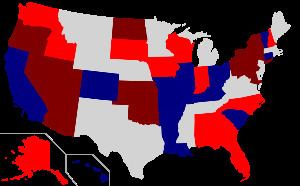41 seats 58 seats 12 12 44.7% 51.6% Start date November 4, 1980 | 53 46 26,597,169 30,699,463 2.9% 1.0% | |
 | ||
Winner Howard Baker Other Instances United States Senate el, United States Senate el, United States Senate el, United States Senate el, United States Senate el | ||
The United States Senate elections, 1980 coincided with Ronald Reagan's victory in the presidential election. Reagan's large margin of victory over incumbent Jimmy Carter pulled in many Democratic voters and gave a huge boost to Republican Senate candidates.
Contents
The Republicans gained a net of 12 seats from the Democrats and gained control of the Senate, 53–46–1. Majority and minority leaders Robert Byrd and Howard Baker exchanged places. This election marked the first time since 1954 that the Republican Party controlled either house of Congress. Despite large gains, Republican Senate candidates lost the popular vote.
This was the largest Senate swing since 1958, and was the largest Republican gain since 1946, when Republicans also picked up 12 seats.
Gains and losses
Without losing any seats, the Republicans took open seats in Alabama, Alaska, and Florida, and unseated nine incumbents: Herman Talmadge (D-GA), Frank Church (D-ID), Birch E. Bayh II (D-IN), John Culver (D-IA), John A. Durkin (D-NH), Robert Morgan (D-NC), 1972 presidential nominee George S. McGovern (D-SD), Warren Magnuson (D-WA), and Gaylord Nelson (D-WI) (see Reagan's coattails).
Later changes
In 1982, Harrison A. Williams (D-NJ) resigned from the Senate rather than face a vote on his expulsion over the Abscam scandal. He was replaced by Republican Nicholas F. Brady. This is not reflected in the party totals.
Complete list of contests
A bolded state name indicates an article about that state's election.
